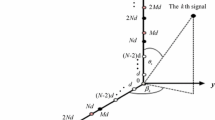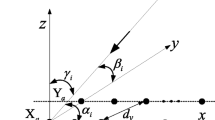Abstract
In this paper, a two-dimensional (2-D) direction of arrival (DOA) estimation algorithm is developed for closely spaced sources with L-shaped array. In the proposed algorithm, we formulate two special matrices related to the covariance matrix of the antenna output by using matrix multiplication, the nonzero eigenvalues and corresponding eigenvectors of which contain the pair matching and DOA information, respectively. The pair-matching procedure is carried out by dealing with the nonzero eigenvalues of two spacial matrices, and theoretical analysis indicates that the pair-matching procedure does not result in the pair-matching failure. The DOAs of the sources are estimated by utilising the eigenvectors corresponding to nonzero eigenvectors, and the DOA estimation accuracy is significantly improved by this means. We also discuss the reason why the presented method can distinguish closely spaced sources. The simulation results validate the performance of the proposed algorithm.








Similar content being viewed by others
References
S.O. Al-Jazzar, D.C. McLernon, M.A. Smadi, SVD-based joint azimuth/elevation estimation with automatic pairing. Signal Process. 90, 1669–1675 (2010)
R. Chavanne, K. Abed-Meraim, D. Medynski, Two-step MUSIC algorithm for improved array resolution, in Proceedings of the 11th IEEE Signal Processing Workshop on Statistical Signal Processing, 512–515 (2002)
M. Donelli, F. Viani, P. Rocca, A. Massa, An innovative multiresolution approach for DOA estimation based on a support vector classification. IEEE Trans. Antennas Propag. 57, 2279–2292 (2009)
J.F. Gu, P. Wei, Joint SVD of two cross-correlation matrices to achieve automatic pairing in 2-D angle estimation problems. IEEE Antennas Wirel. Propag. Lett. 6, 553–556 (2007)
B. Halder, T. Kailath, Efficient estimation of closely spaced sinusoidal frequencies using subspace-based methods. IEEE Signal Process. lett. 4, 49–51 (1997)
A.R. Horn, R.C. Johnson, Matrix Analysis (Cambridge University Press, Cambridge, 1985)
H. Krim, M. Viberg, Two decades of array signal processing research. IEEE Signal Process. Mag. 13, 67–94 (1996)
J.L. Liang, D. Liu, Joint elevation and azimuth direction finding using L-shaped array. IEEE Trans. Antennas Propag. 30, 2136–2141 (2010)
A. Navia-Vazquez, M. Martinez-Ramon, L.E. Garcia-Munoz, C.G. Christodoulou, Approximate kernel orthogonalization for antenna array processing. IEEE Trans. Antennas Propag. 58, 3942–3950 (2010)
X. Nie, L.P. Li, A computationally efficient subspace algorithm for 2-D DOA estimation with L-shaped array. IEEE Signal Process. Lett. 21, 971–974 (2014)
M. Pastorino, A. Randazzo, A smart antenna system for direction of arrival estimation based on a support vector regression. IEEE Trans. Antennas Propag. 53, 2161–2168 (2005)
R. Roy, T. Kailath, ESPRIT-estimation of signal parameters via rotational invariance techniques. IEEE Trans. Acoust. Speech Signal Process. 37, 984–995 (1989)
R.O. Schmidt, Multiple emitter location and signal parameter estimation. IEEE Trans. Antennas Propag. 3, 276–280 (1986)
D.N. Swingler, Simple approximations to the Cramer-Rao lower bound on direction of arrival for closely spaced sources. IEEE Trans. Signal Process. 41, 1668–1672 (1993)
H. van Tree, Detection, Estimation, and Modulation Theory-Part IV Optimum Array Processing (Wiley, New York, 2002)
G.M. Wang, J.M. Xin, N.N. Zheng, A. Sano, Computationally efficient subspace-based method for two-dimensional direction estimation with L-shaped array. IEEE Trans. Signal Process. 59, 3197–3212 (2011)
M. Wax, T. Kailath, Detection of signal by information theoretic criteria. IEEE Trans. Acoust. Speech, Signal Process. 33, 387–392 (1985)
Y.S. Wei, X.J. Guo, Pair-matching method by signal covariance matrices for 2D-DOA estimation. IEEE Antennas Wirel. Propag. Lett. 13, 1199–1202 (2014)
Author information
Authors and Affiliations
Corresponding author
Rights and permissions
About this article
Cite this article
Xi, N., Guobing, Q., Xianbing, X. et al. A 2-D DOA Estimation Algorithm for Closely Spaced Sources with L-Shaped Array. Circuits Syst Signal Process 36, 4498–4511 (2017). https://doi.org/10.1007/s00034-017-0525-6
Received:
Revised:
Accepted:
Published:
Issue Date:
DOI: https://doi.org/10.1007/s00034-017-0525-6




